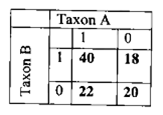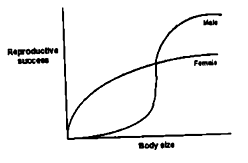 Multiple Choice Questions
Multiple Choice QuestionsWhich of the following organisms do not possess the ability to fix nitrogen?
Organisms specialized for high altitude
Marine plankton
Eukaryotic organisms
Acidophilic organisms
Four Cnidarians with the following characteristics were observed:
A. Asexual polyps and sexual medusa; solitary or colonial; both freshwater and marine.
B. Polyp stage reduced or absent, medusa with velue; solitary; all marine.
C. Polyp stage reduced, bell shaped medusa; solitary; all marine.
D. All polyps, no medusa; solitary or colonial; all marine
They can be identified to their respective classes:
A- Scyphoza; B – Anthozoa; C – Cubozoa; D – Hydrozoa
A – Hydrozoa; B – Scyphoza; C – Cubozoa; D – Anthozoa
A – Anthozoa; B – Cubozoa; C – Hydrozoa; D ; Scyphozoa
A – Cubozoa; B – Scyphozoa; C – Anthozoa; D – Hydrozoa
The following table shows the summary of characters between two taxa based on presence (1) and absence (0) data

Which of the following represents Jaccard’s coefficient and Simple matching coefficient respectively?
0.8, 0.5
0.6, 0.5
0.8, 0.6
0.5, 0.6
Identify the proteobacteria based on the key given below:
i.Cause disease in humans (ii)
i. Do not cause disease in humans (iii)
ii. An obligate intracellular parasite (A)
ii. Not an obligate intracellular parasite (B)
iii. Live in insects (C)
iii. Do not in insects (iv)
iv. Chemoautotrophic (D)
iv. Not chemoautotrophic (v)
v. Plant pathogen (E)
v. Not a plant pathogen (vi)
vi. Fix nitrogen (vii)
vi.Do not fix nitrogen (F)
vii. Associated with legumes (G)
vii. Not associated with legumes (H)
A – Rickettsia; B – Brucella ; C – Wolbachia; D – Nitrobacter; E – Agrobacterium; F – Acetobacter; G – Rhizobium; H – Azospirillum
A – Rickettsia; B – Wolbachia; C – Brucella; D – Nitrobacter; E – Acetobacter; F – Agrobacterium; G – Rhizobium; H – Azospirillum
A – Rickettsia; B – Brucella; C – Wolbachia; D – Nitrobacter; E – Agrobacterium; F – Acetobacter; G – Azospirillum; H – Rhizobium
A – Rickettsia; B – Brucella; C – Wolbachia; D – Nitrobacter; E – Acetobacter; F – Agrobacterium; G – Azospirillum; H – Rhizobium
A.
A – Rickettsia; B – Brucella ; C – Wolbachia; D – Nitrobacter; E – Agrobacterium; F – Acetobacter; G – Rhizobium; H – Azospirillum
The proteobacteria are-
A – Rickettsia; B – Brucella ; C – Wolbachia; D – Nitrobacter; E – Agrobacterium; F – Acetobacter; G – Rhizobium; H – Azospirillum
Species characteristics that make them more prone to extinction are listed below:
A. High degree of specialization
B. High sexual dimporphism
C. High trophic status
D. Short life span.
Which of the following is the correct combination?
A, B and C
A, C and D
A, B and D
B, C and D
If the relationship between life time reproductive success and body size for males and females of a species as shown in figure below:

The species is most likely to evolve
Sexual dimorphism
Asexual reproduction
Polyandry
Obligate monogamy
Wolbachia are obligate intracellular bacteria, many different strains of which are abundantly present in insects. They induce mating incompatibility in host, i.e. males infected with one strain can only fertilize females infected with the same strain. No other pathological effects are observed in host. A possible evolutionary consequence of this phenomenon would be:
Extinction of many insect species.
Termination of sexual reproduction in many insect species
Co-extinction of host and parasite
Reproductive isolation leading to rapid speciation in insects
In a tissue, cells are bound together by physical attachment between cell to cell or between cells to the extracellular matrix. Following are some of the characteristics of cell junctions:
(A) Adherens junctions are cell-cell anchoring junctions connecting actin filament in one cell with that in the next cell.
(B) Desmosomes are cell-matrix anchoring junctions connecting actin filament in one cell to extracellular matrix.
(C) Gap junctions are channel-forming junctions allowing passage of small water-soluble molecules from cell to cell.
(D) Tight junctions are occluding junctions, which seal the gap between two cells.
(E) Hemidesmosomes are cell-matrix anchoring junctions connecting intermediate filament in one cell to extracellular matrix.
Which of the following combination of statements is NOT correct?
(A) and (B)
(A) and (C)
(C) and (D)
(D) and (E)
In the contexts of the proximal-distal growth and differentiation of a tetrapod limb following experiments were visualized:
(A) If the apical ectodermal ridge (AER) is removed at any time during the limb development, further development of distal limb skeletal elements ceases.
(B) If leg mesenchyme is placed directly beneath the wing AER, distal hindlimb structures develop at the end of the limb.
(C) If an extra AER is grafted onto an existing limb dud, supernumerary structures are formed usually at the distal end of the limb.
(D) If leg mesenchyme is placed directly beneath the wing AER, proximal hindlimb structures develop at the end of the limb.
Which of the above experiments would show the possible interactions between the AER and the limb bud mesenchyme directly beneath it during limb development?
(A) and (B) only
(B) and (C) only
(C) and (D) only
(A), (B), and (C)
Which of the following hypothesis best explains the occurrence of Himalayan floral elements in Western Ghats of India?
Continental drift theory
Deccan trap theory
Himalayan Glaciation theory
Coromandel coast hypothesis
